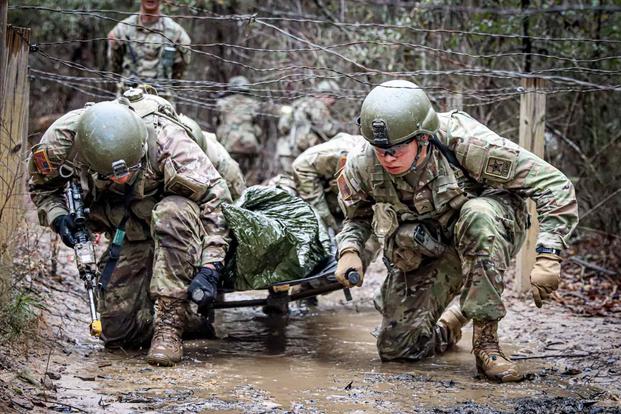Women are at least twice as likely as men to be injured in Army basic training, according to data collected over six years by the service.
Most of those injuries were musculoskeletal -- meaning they affect the bones, muscles, joints and tendons of female recruits. Military.com obtained the injury data as the Army is looking for ways to boost recovery for men and women moving through boot camp.
During 2022, nearly 30% of female recruits were injured on average each month during Army basic training. The average was 23% per month between 2017 and 2022, the data shows. During those years, about 12% of male recruits were injured each month.
Read Next: Air Force Superiors Warned Alleged Pentagon Leaker Multiple Times Before Arrest
The gap between male and female injuries in Army basic training isn't unique to the military.
Female athletes are also typically more prone to injury compared to their male counterparts, with women being more likely to receive bone and knee ligament injuries and stress fractures, according to a 2018 study published in the Physical Medicine & Rehabilitation medical journal. Part of that is due to women having smaller bones and less muscle mass.
Prior data also identified injury disparities among recruits based on where they come from within the U.S. Recruits from the South were among the most likely to be injured in basic training.
Researchers found that 34% of the Army's 99,335 trainees in 2017 sustained at least one musculoskeletal injury. Half of those injured were from eight states -- Louisiana, Mississippi, Alabama, Florida, Georgia, South Carolina, Tennessee and North Carolina, according to a December 2022 study published in the Progress in Cardiovascular Diseases medical journal.
The South has the highest prevalence of obesity, something researchers have associated with a cluster of risk factors including restrictions on high-quality fitness facilities, health care and healthy food. Large swaths of the South also have relatively low household incomes, putting easy access to fitness training and healthy foods even further out of reach.
Overall, the Army, like the other services, is struggling to find recruits who can make the cut and pass the physically grueling basic training. Teens who are the prime recruiting demographic are becoming less physically active, creating a significant challenge for the Army.
Youth sports are also becoming less popular, and nearly half of Americans 12 to 21 years old are not physically active on a regular basis, according to data from the Centers for Disease Control and Prevention.
To improve boot camp performance, the Army started offering one nutrition bar per day to basic trainees in 2018. Those bars are high in calcium and vitamin D, which help with bone strength, and have about 12 grams of protein.
The service also started fielding more athletic trainers in 2020, including physical therapists and strength coaches, to Fort Moore, Georgia, which was previously known as Fort Benning. That base is where the service trains its ground combat troops, including infantry and cavalry scouts. Trainers were also placed at Fort Jackson, South Carolina.
Meanwhile, the Army in recent years has dramatically overhauled how it conducts physical training generally. That includes specific fitness tests to measure whether an applicant is qualified for certain jobs in the force, placing a greater emphasis on recovery, and boosting overall fitness standards within its formations.
But the service also balked at further changes to its new physical fitness test -- the Army Combat Fitness Test, or ACFT, after numerous revisions. That test is much more complicated than its predecessor and is largely seen as a better measurement of a soldier's athletic ability. Like other fitness tests before it, the ACFT has different scoring standards based on age and gender.
Congress passed a law pressing the Army to create gender-neutral fitness standards, but did not specify those standards have to be through the ACFT. Secretary Christine Wormuth said last month the service already has appropriate standards in place.
In 2017, the Army implemented the Occupational Physical Assessment Test, or OPAT, an entry fitness test for new recruits. Performance on the test, which includes measuring how far a recruit can jump, throw a ball and how much they can deadlift, dictates what job a recruit is eligible for. Army leaders touted the OPAT as an early success, saying in 2018 that they saw about 10% fewer basic training dropouts.
Editor's note: The story has been updated with context about the Army's decisions on gender-neutral physical fitness policies.
-- Steve Beynon can be reached at Steve.Beynon@military.com. Follow him on Twitter @StevenBeynon
Related: Recruits, Especially from the South, Are Getting Injured at Alarming Rates in Basic Training











